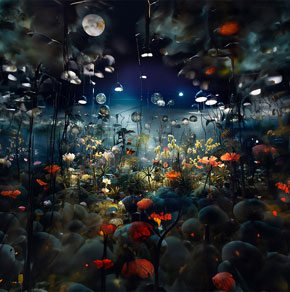2.3.25 — A Garden at Night
For Mary Mattingly, nature’s most intense colors come out only at night. One could almost call them supernatural.
Mattingly photographs an exotic garden, set in an uncertain world. Its glow seems to come from the flowers themselves, in dense clusters of yellow, orange, purple, and blue. They run more to spheres than to the petals, like artificial lights. The surrounding greenery could almost stand in for wiring in a museum or holiday display. 
They pop, but Mattingly’s “Night Garden” cannot altogether penetrate the darkness, at Robert Mann through February 22. Just try to imagine where you are. It could be underwater for the depth of black and the shimmer of light now and on the surface. Could those be fish swimming by or just more flowers soaking up the light show? They could belong to a nighttime landscape as well, with distant hills, more than once, and a full moon. It unfolds in layers, including layered flowers, like a landscape painter’s means of defining depth. The shimmers form veils or curtains waiting to be pulled aside.
Not that one could expect to see more, not when color like this cannot penetrate the darkness. The heightened contrast between elements helps create the interplay of natural and unnatural. Nature here seems perfectly well observed, in a painterly tradition going back the Romantic landscape and to flowers in close-up from Baroque still life through Beatrix Potter to Georgia O’Keeffe. Double exposures and darkroom additions, I assume, are allowed, including actual lamps, but nothing in violation of ordinary linear perspective. Hills have the breadth of the Hudson River School and an atmospheric blue. A trained eye could identify the flowers.
Mary Mattingly must have trained herself all over again. She began modestly enough, with twilight visits to Socrates Sculpture Park on the East River waterfront, where she has herself contributed her Water Clock. One may remember it more for trees, lawns, and art than for flowers, with the Noguchi Museum a block or two away. One may expect less of nature anyway in the coldest weeks of the year. Try to enjoy the irony of a school football a quarter mile up on Broadway with strictly artificial turf. But then the photos have no indication of place or time.
She began, then, not in the studio, but with chance discoveries in a neighborhood respite. It is hardly a botanic garden, but it will have to do. Still, she says, the park inspired her to take clippings from its flowers and to study them with care. Yet the crispness and color come equally from photography. Remember the bright, halfway creepy look of early color photography, as with William Eggleston, when they hardly passed for art? Mattingly retains that look but in the color that she has seen.
A skeptic could find a little too much artifice and beauty. These photos do not shy away from special effects. And who can object, as in her past work, to reminders of climate change? Still, she knows what to keep in reserve in the blackness. It obliges one to see art and photography, too, as a work of the imagination rather than a mechanical record—and a discovery as much as a creation. Maybe sunlight will return come summer, but for now it is up to you to say where and when you are.
Read more, now in a feature-length article on this site.